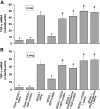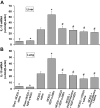Melanocortins protect against multiple organ dysfunction syndrome in mice
- PMID: 21039420
- PMCID: PMC3042202
- DOI: 10.1111/j.1476-5381.2010.01098.x
Melanocortins protect against multiple organ dysfunction syndrome in mice
Abstract
Background and purpose: Melanocortins reverse circulatory shock and improve survival by counteracting the systemic inflammatory response, and through the activation of the vagus nerve-mediated cholinergic anti-inflammatory pathway. To gain insight into the potential therapeutic value of melanocortins against multiple organ damage following systemic inflammatory response, here we investigated the effects of the melanocortin analogue [Nle⁴ D-Phe⁷]α-MSH (NDP-α-MSH) in a widely used murine model of multiple organ dysfunction syndrome (MODS).
Experimental approach: MODS was induced in mice by a single intraperitoneal injection of lipopolysaccharide followed, 6 days later (= day 0), by zymosan. After MODS or sham MODS induction, animals were randomized to receive intraperitoneally NDP-α-MSH (340 µg·kg⁻¹ day) or saline for up to 16 days. Additional groups of MODS mice were concomitantly treated with the melanocortin MC₄ receptor antagonist HS024, or the nicotinic acetylcholine receptor antagonist chlorisondamine, and NDP-α-MSH.
Key results: At day 7, in the liver and lung NDP-α-MSH, significantly reduced mRNA expression of tumour necrosis factor-α (TNF-α), increased mRNA expression of interleukin-10 and improved the histological picture, as well as reduced TNF-α plasma levels; furthermore, NDP-α-MSH dose-dependently increased survival rate, as assessed throughout the 16 day observation period. HS024 and chlorisondamine prevented all the beneficial effects of NDP-α-MSH in MODS mice.
Conclusions and implications: These data indicate that NDP-α-MSH protects against experimental MODS by counteracting the systemic inflammatory response, probably through brain MC₄ receptor-triggered activation of the cholinergic anti-inflammatory pathway. These findings reveal previously undescribed effects of melanocortins and could have clinical relevance in the MODS setting.
© 2011 The Authors. British Journal of Pharmacology © 2011 The British Pharmacological Society.
Figures






Similar articles
-
Melanocortin 4 receptor activation protects against testicular ischemia-reperfusion injury by triggering the cholinergic antiinflammatory pathway.Endocrinology. 2011 Oct;152(10):3852-61. doi: 10.1210/en.2011-1016. Epub 2011 Aug 9. Endocrinology. 2011. PMID: 21828180 Free PMC article.
-
Selective melanocortin MC4 receptor agonists reverse haemorrhagic shock and prevent multiple organ damage.Br J Pharmacol. 2007 Mar;150(5):595-603. doi: 10.1038/sj.bjp.0707115. Epub 2007 Jan 22. Br J Pharmacol. 2007. PMID: 17245369 Free PMC article.
-
NDP-α-MSH attenuates heart and liver responses to myocardial reperfusion via the vagus nerve and JAK/ERK/STAT signaling.Eur J Pharmacol. 2015 Dec 15;769:22-32. doi: 10.1016/j.ejphar.2015.10.022. Epub 2015 Oct 22. Eur J Pharmacol. 2015. PMID: 26477637
-
Melanocortins and cardiovascular regulation.Eur J Pharmacol. 1998 Oct 30;360(1):1-14. doi: 10.1016/s0014-2999(98)00615-3. Eur J Pharmacol. 1998. PMID: 9845266 Review.
-
Melanocortins and their receptors and antagonists.Curr Drug Targets. 2003 Oct;4(7):586-97. doi: 10.2174/1389450033490858. Curr Drug Targets. 2003. PMID: 14535656 Review.
Cited by
-
NDP-MSH inhibits neutrophil migration through nicotinic and adrenergic receptors in experimental peritonitis.Naunyn Schmiedebergs Arch Pharmacol. 2013 Apr;386(4):311-8. doi: 10.1007/s00210-013-0834-7. Epub 2013 Jan 22. Naunyn Schmiedebergs Arch Pharmacol. 2013. PMID: 23338711
-
Activation of melanocortin receptor 4 with RO27-3225 attenuates neuroinflammation through AMPK/JNK/p38 MAPK pathway after intracerebral hemorrhage in mice.J Neuroinflammation. 2018 Apr 11;15(1):106. doi: 10.1186/s12974-018-1140-6. J Neuroinflammation. 2018. PMID: 29642894 Free PMC article.
-
Melanocortin 4 receptor activation protects against testicular ischemia-reperfusion injury by triggering the cholinergic antiinflammatory pathway.Endocrinology. 2011 Oct;152(10):3852-61. doi: 10.1210/en.2011-1016. Epub 2011 Aug 9. Endocrinology. 2011. PMID: 21828180 Free PMC article.
-
Antifibrotic and Anti-Inflammatory Actions of α-Melanocytic Hormone: New Roles for an Old Player.Pharmaceuticals (Basel). 2021 Jan 8;14(1):45. doi: 10.3390/ph14010045. Pharmaceuticals (Basel). 2021. PMID: 33430064 Free PMC article. Review.
-
Biphasic effect of melanocortin agonists on metabolic rate and body temperature.Cell Metab. 2014 Aug 5;20(2):333-45. doi: 10.1016/j.cmet.2014.05.021. Epub 2014 Jun 26. Cell Metab. 2014. PMID: 24981835 Free PMC article.
References
-
- Altavilla D, Guarini S, Bitto A, Mioni C, Giuliani D, Bigiani A, et al. Activation of the cholinergic anti-infiammatory pathway reduces NF-kB activation, blunts TNF-α production, and protects against splanchnic artery occlusion shock. Shock. 2006;25:500–506. - PubMed
-
- Banks WA, Kastin AJ. Permeability of the blood-brain barrier to melanocortins. Peptides. 1995;16:1157–1161. - PubMed
-
- Baue AE. Multiple organ failure, multiple organ dysfunction syndrome and systemic inflammatory response syndrome. Why no magic bullets? Arch Surg. 1997;132:703–707. - PubMed
Publication types
MeSH terms
Substances
LinkOut - more resources
Full Text Sources

